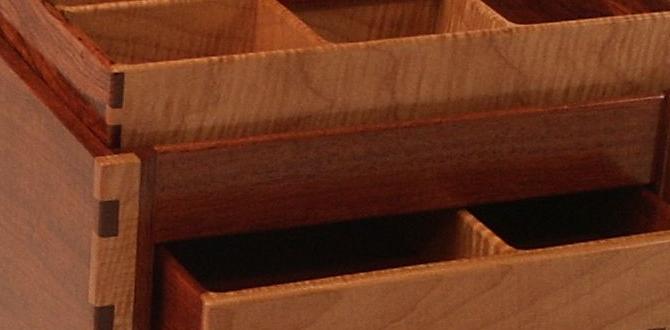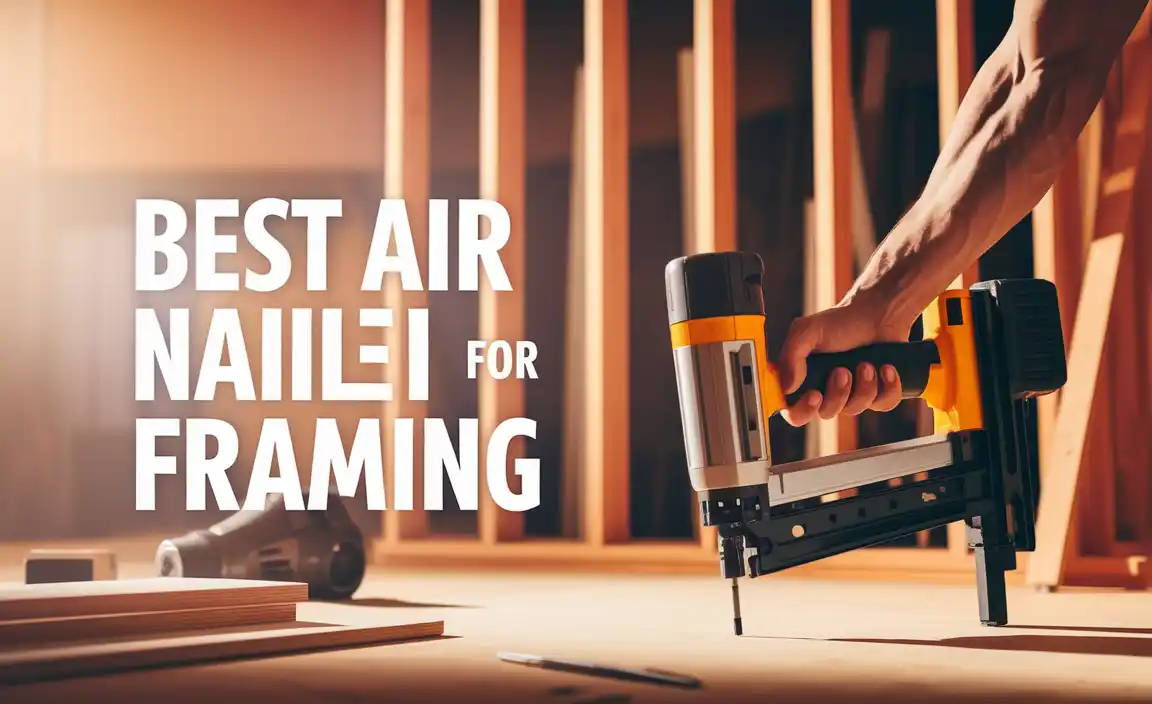Quick Summary:
Yes, you can use nail guns in cold weather, but it requires preparation. Keep your tools warm, use the right air pressure, and select appropriate lubricants to prevent freezing and ensure reliable performance. Follow these essential tips for safe and effective cold-weather nailing.
Hey there, DIYers and fellow woodworkers! Jack Shaffer here from Nailerguy. Ever found yourself ready to tackle that weekend project, only to be met with a biting cold that makes you second-guess bringing your trusty nail gun out? You’re not alone. Working with power tools in chilly temperatures can feel a bit daunting, and nail guns are no exception.
The good news is, you absolutely can get the job done even when the mercury dips. It just takes a little extra know-how and a few simple precautions. We’re going to walk through exactly what you need to do to keep your nail gun firing smoothly and safely, no matter how cold it gets outside.
Let’s break down everything you need to consider to make your cold-weather nailing projects a success. We’ll cover everything from tool storage to air supply, making sure you’re prepared for any chilly build.
Table of Contents
Why Cold Weather is a Challenge for Nail Guns
Those impressive little machines we call nail guns rely on compressed air to do their work. When the temperature drops, several things can happen that affect how they operate:
- Air Pressure Changes: As air cools, its pressure decreases. This means your compressor might not deliver the consistent pressure your nail gun needs for optimal performance.
- Moisture Freezing: This is a big one! Water vapor in the air can condense inside your nail gun and air lines. In freezing temperatures, this moisture can turn into ice, jamming mechanisms, blocking air passages, and potentially causing damage.
- Lubricant Issues: Standard tool oils might thicken or even freeze in extreme cold, hindering the smooth movement of internal parts.
- Material Brittleness: While not directly a nail gun issue, extremely cold materials can become more brittle, increasing the risk of cracking or splintering when nails are driven.
- User Discomfort: Let’s be honest, cold hands and numb fingers make precise work difficult and increase the risk of accidents.
Getting Your Gear Ready: Pre-Project Checks
Before you even step outside into the cold, giving your nail gun and accessories a little attention can save you a lot of headaches on the job site. Think of it as a warm-up for your tools!
1. Tool Storage is Key
Where you store your nail gun when it’s not in use makes a huge difference.
- Indoors is Best: If possible, store your nail gun in a warm, dry place. Bringing it from a warm environment to a cold one means more condensation will form as the tool acclimates.
- Minimize Temperature Changes: If you have to store it in a cold garage or shed, try to minimize how often it goes back and forth between extreme temperatures.
- Consider Tool Bags: Padded tool bags can offer a small amount of insulation, but they won’t prevent freezing in truly extreme cold.
2. Inspecting Your Nail Gun
A quick once-over can catch potential problems before they start.
- Cleanliness First: Ensure your nail gun is clean. Dirt and debris can combine with moisture to create blockages.
- Check for Damage: Look for any cracks or worn parts, especially on seals and O-rings. Extreme cold can make rubber and plastic more brittle.
- Manual Check: Briefly cycle the trigger and nose piece without air connected to ensure the mechanism moves freely.
Essential Cold-Weather Nail Gun Accessories
Beyond the nail gun itself, a few key accessories are crucial for battling the cold.
1. Air Compressors and Hoses
Your air source is just as susceptible to cold weather as your nail gun.
- Compressor Location: If possible, keep your compressor indoors or in a sheltered area to keep it warmer and drier. This also helps reduce noise for your neighbors!
- Air Hoses: Look for hoses designed for cold weather use. Standard rubber hoses can become stiff and prone to cracking in freezing temperatures. Polyurethane or specific cold-weather-rated hoses are more flexible.
- Hose Length: Shorter hoses mean less air volume to cool down and less chance for moisture to condense over a long travel distance.
2. Air Filters and Regulators
These are your front-line defense against water and improper pressure.
- Moisture Traps/Filters: This is non-negotiable. Use a high-quality in-line desiccant dryer or an air filter with an automatic drain. These remove moisture from the compressed air before it even reaches your nail gun. For extreme cold, consider heated air dryers, though these are typically found on professional job sites.
- Regulator: Ensure your regulator is functioning correctly. You’ll need to set it accurately to account for potential pressure drops due to temperature.
3. Lubrication – The Right Stuff Matters!
Proper lubrication is vital, but the type of oil is critical in the cold.
- Use Cold-Weather Rated Oil: Standard pneumatic tool oil can thicken or freeze. Look for lubricants specifically formulated for cold temperatures. These oils have a lower pour point, meaning they remain fluid at lower temperatures.
- Avoid WD-40 as Lubricant: While great for cleaning and water displacement, WD-40 is not a long-term lubricant for air tools and can actually dry out seals over time.
- How to Lubricate: Add a few drops of the appropriate oil into the air inlet port of your nail gun according to the manufacturer’s instructions. Do this before the first use of the day and periodically throughout the day, especially if you notice performance issues.
| Accessory | Why it’s Important in Cold Weather | Recommendation |
|---|---|---|
| Cold-Weather Air Hose | Prevents hoses from becoming stiff, brittle, and cracking in sub-freezing temperatures. Retains flexibility. | Choose hoses rated for low temperatures (e.g., polyurethane). |
| In-Line Moisture Dryer/Filter | Removes condensation from the air supply, preventing ice buildup inside the nail gun. Crucial for preventing jams. | Ensure it has an automatic drain or is manually drained frequently. Consider heated dryers for very low temps. |
| Cold-Weather Pneumatic Tool Oil | Keeps internal moving parts lubricated and prevents oil from thickening or freezing, ensuring smooth operation. | Use lubricants specifically designed for low temperatures. |
| Air Pressure Regulator | Maintains consistent output pressure from the compressor, accounting for potential drops due to cold air. | Check and adjust pressure as needed throughout the job. |
Step-by-Step Guide: Using Your Nail Gun in Cold Weather
Alright, let’s get down to business. Here’s how to set up and use your nail gun safely and effectively when it’s chilly out.
-
Warm Up Your Tools (If Possible)
If you stored your nail gun indoors, don’t immediately take it out into the freezing cold. Let it acclimate partially. Similarly, run your compressor for a few minutes indoors before connecting it to the cold hose and nail gun. This helps reduce initial condensation.
-
Connect Your Air System Properly
Attach your cold-weather-rated hose to the compressor and then to your nail gun. Ensure all connections are snug to prevent air leaks, which are even more problematic in the cold.
-
Install Your Moisture Management System
Make sure your in-line moisture filter or dryer is connected between the hose and the nail gun. If it has a manual drain valve, be prepared to drain it frequently. If it’s automatic, observe it to ensure it’s working.
-
Lubricate Your Nail Gun
Add 2-3 drops of cold-weather-rated pneumatic tool oil into the air inlet port. Re-lubricate every couple of hours or if you notice any sluggishness.
-
Set the Correct Air Pressure
This is crucial. Consult your nail gun’s manual for the recommended operating pressure. Because cold air is denser and has lower pressure, you might need to slightly increase the pressure setting on your regulator compared to warmer temperatures to achieve the same driving force. Start on the lower end of the recommended range and gradually increase if needed. A good starting point might be around 80-100 PSI, but always check your tool’s manual. You can find general guidelines for pneumatic tool pressure from resources like OSHA, though always defer to your tool’s specific requirements. Incorrect pressure is a common cause of under-driven or over-driven nails.
-
Perform a Test Fire
Before starting your project, fire a few nails into a scrap piece of wood. Ensure the nails are driven to the desired depth. If they are not fully set, increase the air pressure slightly on your regulator. If they are driving too deep or causing excessive splintering, decrease the pressure. Listen for any unusual sounds or hesitations.
-
Work in Short Bursts (If Possible)
If you’re working in very cold conditions, take breaks to warm up yourself and your tools. Bring the nail gun indoors for a bit if it starts acting sluggish. This helps prevent prolonged exposure to extreme cold and minimizes moisture buildup.
-
Drain Air Lines and Compressor
At the end of your work session, disconnect the air hose from the nail gun first (to release pressure). Then, disconnect the hose from the compressor. Drain any moisture from the air lines by holding them upside down. If your compressor has a tank, drain it thoroughly to remove accumulated water. This step is vital for preventing internal freezing and corrosion.
Troubleshooting Common Cold-Weather Nail Gun Issues
Even with the best preparation, you might encounter a hiccup or two. Here’s how to deal with them:
-
Nails Not Firing or Weak Shots:
- Check Air Pressure: Is it set correctly? Has it dropped?
- Check for Blockages: Moisture might have frozen. Disconnect the air supply and try to gently clear the nose piece. Sometimes warming the nose with your hands can help melt small ice blockages.
- Lubrication: Add more cold-weather oil.
- Moisture Filter: Is it clogged or not draining?
-
Nail Gun Jamming:
- Disconnect Air Immediately: Never force a jammed nail gun.
- Remove Nails: Carefully unload any remaining nails from the magazine.
- Inspect Mechanism: Gently try to see if a nail is bent or stuck in the firing mechanism. Follow your tool’s manual for jam clearing.
- Warmth Helps: If you suspect ice, try warming the tool gently. A hair dryer on a low setting (held at a distance) can be used cautiously, but avoid overheating or melting plastic parts.
-
Air Leaks:
- Check Connections: All connections from the compressor to the nail gun can leak. Tighten them up. Cold can make seals less pliable, sometimes exacerbating minor leaks.
- Inspect O-rings and Seals: Cold can make these brittle. If you find cracked or damaged seals, they’ll need to be replaced.
-
Sluggish Operation:
- Lubrication: Add more cold-weather oil.
- Air Pressure: Ensure sufficient and consistent pressure.
Safety First, Always!
Working in the cold can make you less aware, so it’s extra important to keep safety at the forefront.
- Wear Appropriate Clothing: Layer up with warm, waterproof clothing. Wear insulated gloves that still allow for dexterity. Consider work boots with good traction.
- Protect Your Eyes: Safety glasses are a must, even in the cold.
- Keep Work Area Clear: Slippery surfaces are more dangerous in winter. Ensure your work area is as clear and safe as possible.
- Take Breaks: Don’t push through extreme cold for too long. Take regular breaks to warm up indoors. Frostbite and hypothermia are serious risks.
- Stay Hydrated: Even in the cold, staying hydrated is important for your body’s function.
- Understand Your Tool: Read your nail gun’s manual thoroughly. Familiarize yourself with its safety features and recommended operating procedures. Organizations like ToolHelp.com offer excellent general safety advice for nail guns.
When to Call it a Day
There will be times when the weather is just too extreme, even with all the precautions. If temperatures are dangerously low (e.g., significantly below freezing, especially with wind chill), and your tools are fighting you every step of the way, it might be time to reschedule. Safety of yourself and the longevity of your tools should always come first. Listen to your body and your tools – if they are telling you it’s too much, it probably is.
Frequently Asked Questions About Using Nail Guns in Cold Weather
Q1: Can I use my regular nail gun oil in freezing temperatures?
A: No, it’s not recommended. Standard pneumatic tool oil can thicken or even freeze in cold weather, hindering lubrication and potentially damaging your tool. Always use a cold-weather-rated lubricant specifically designed for low temperatures.
Q2: How does cold air affect my nail gun’s performance?
A: Cold air is denser and has lower pressure. This can lead to weaker shots or inconsistent performance. For optimal results, you might need to slightly increase the air pressure setting on your regulator to compensate for the ambient temperature.
Q3: My nail gun is jamming more often in the cold. What’s happening?
A: This is likely due to moisture in the air freezing inside the nail gun or air lines. Using a good in-line moisture filter and draining your system frequently are key to preventing this.
Q4: Do I need a special air hose for cold weather?
A: Yes, it’s highly recommended. Standard rubber hoses can become stiff, brittle, and prone to cracking in freezing temperatures. Opt for a cold-weather-rated hose (often made of polyurethane) that remains flexible.
Q5: How can I prevent moisture buildup in my air system?
A: The best methods include using an in-line moisture filter or desiccant dryer, draining your compressor tank regularly, and draining your air hoses after each use. Always use cold-weather-rated lubricants.
Q6: Is it safe to try and warm up a frozen nail gun with a heat gun?
A: Use extreme caution if attempting to warm a tool. A professional might use a hair dryer on a low setting from a distance, but direct heat from a heat gun can melt plastic components or damage seals. It’s usually better to let the tool warm up naturally by bringing it into a heated space



